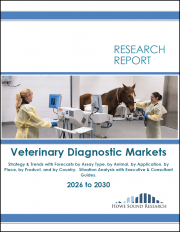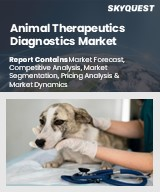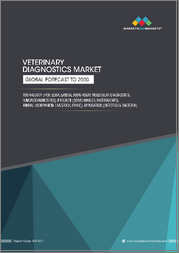
|
시장보고서
상품코드
1576961
일본의 동물 진단 시장 평가 : 제품 유형별, 기술별, 동물 유형별, 용도별, 최종사용자별, 지역별, 기회, 예측(2018-2032년)Japan Veterinary Diagnostics Market Assessment, By Product, By Technology, By Animal Type, By Application, By End-user, By Region, Opportunities and Forecast, FY2018-FY2032F |
||||||
일본의 동물 진단 시장 규모는 2024년 2억 5,252만 달러에서 2032년 5억 1,541만 달러에 달할 것으로 예상되며, 2025-2032년 예측 기간 동안 연평균 9.33% 성장할 것으로 예상됩니다. 시장 성장은 전염병 발생 증가, 정부의 노력 강화, 첨단 기술을 활용한 진단 솔루션의 가용성, 반려동물 사육 증가 등에 의해 뒷받침되고 있습니다. 동물 의료 부문을 강화하려는 정부의 노력과 국내 수의사의 증가는 일본의 동물 진단 시장 규모를 높이고 있으며, 2023년 6월 현재 일본 수의사 협회(JVMA)는 55개 협회를 통해 일본 전역에 걸쳐 28,000명의 수의사를 대표하고 있습니다.
또한, 수의사들의 정기적인 예방접종과 건강검진에 대한 옹호로 인해 동물 예방의학에 대한 관심이 높아지면서 일본 동물용 진단 시장의 성장세를 견인하고 있습니다. 질병을 조기에 발견할 수 있는 새로운 진단 도구가 도입되고 있으며, 이는 예방 수의학으로의 전환과 일치합니다. 또한, 공중보건과 식품 안전에 대한 관심이 높아지면서 일본 내 동물용 진단에 대한 수요도 증가하고 있습니다. 동물 진단은 가축의 건강을 보장하고 가축이 식용으로 가공되기 전에 병원균을 선별하는 데 중요한 역할을 합니다. 또한 전염병은 식품 안전에 심각한 영향을 미칠 수 있기 때문에 전염병 모니터링에도 도움이 됩니다. 따라서 진단 검사는 병원균이 식품 공급망에 유입되어 인간에게 감염되는 것을 방지하기 위해 필수적입니다.
또한, 분자진단, 현장진단, 신속검사 키트 등 동물의료 진단 부문의 급속한 발전으로 동물의료 진단 솔루션의 접근성과 효율성이 향상되고 있습니다. 이처럼 정확한 결과를 적시에 제공함으로써 동물 의료 분야에서 이러한 신기술의 채택이 증가하고 있습니다.
본 보고서는 일본의 동물용 의료 진단 시장에 대해 조사 분석하여 시장 규모와 예측, 시장 역학, 주요 기업 현황 등을 제공합니다.
목차
제1장 프로젝트 범위와 정의
제2장 조사 방법
제3장 주요 요약
제4장 일본의 동물 진단 시장 전망(2018년도-2032년도)
- 시장 규모 분석과 예측
- 금액
- 시장 점유율 분석과 예측
- 제품별
- 기술별
- 동물 유형별
- 용도별
- 최종사용자별
- 지역별
- 시장 점유율 분석 : 기업별(금액)(주요 기업과 기타 - 2024년도)
- 시장 맵 분석(2024년도)
- 제품별
- 기술별
- 동물 유형별
- 용도별
- 최종사용자별
- 지역별
제5장 수급 분석
제6장 수입과 수출 분석
제7장 밸류체인 분석
제8장 Porter's Five Forces 분석
제9장 PESTLE 분석
제10장 가격 분석
제11장 시장 역학
- 시장 성장 촉진요인
- 시장 과제
제12장 시장 동향과 발전
제13장 규제 프레임워크와 혁신
- 임상시험
- 규제 당국 승인
제14장 특허 상황
제15장 사례 연구
제16장 경쟁 상황
- 주요 시장 리더 경쟁 매트릭스
- 주요 기업 SWOT 분석
- 시장 주요 기업의 상황
- IDEXX Laboratories, Inc.
- Zoetis Services LLC
- Virbac S.A.
- Neogen Corporation
- bioMerieux SA
제17장 전략적 추천
제18장 당사 소개와 면책사항
ksm 24.10.31Japan veterinary diagnostics market is projected to witness a CAGR of 9.33% during the forecast period FY2025-FY2032, growing from USD 252.52 million in FY2024 to USD 515.41 million in FY2032. The market's growth is supported by rising outbreaks of infectious diseases, increasing government efforts, availability of technologically advanced diagnostic solutions, and rising adoption of pets. The government's efforts to strengthen the animal healthcare sector, coupled with the increasing number of veterinary professionals in the country, are boosting Japan's veterinary diagnostics market size. As of June 2023, the Japan Veterinary Medical Association (JVMA) represents 28,000 veterinarians across Japan through their 55 associations.
Furthermore, the growing emphasis on preventive healthcare for animals due to veterinary professionals advocating for regular vaccinations and check-ups is also bolstering the Japan veterinary diagnostics market growth. Novel diagnostic tools are also being introduced in the country to enable early disease detection, aligning with the shift toward preventive veterinary care. Moreover, the growing emphasis on public health and food safety is also augmenting the requirement for veterinary diagnostic products in Japan. Veterinary diagnostics play a crucial role in ensuring the livestock's health and screening pathogens before the animals are processed for food production. It also aids in monitoring infectious diseases, as these diseases can significantly impact the safety of food products. Diagnostic testing is thus essential to ensure that pathogens do not enter the food supply chain and get transmitted to humans.
Additionally, rapid advancements in the veterinary diagnostics sector, including molecular diagnostics, point-of-care testing, and rapid testing kits, are increasing the accessibility and efficiency of veterinary diagnostic solutions. Thus, providing more accurate results in a timely manner results in increased adoption of these novel technologies by veterinary practices.
Increasing Government Efforts Support Market Expansion
The rising effort of the Japanese government to bolster awareness about the importance of ensuring animal health is providing lucrative growth opportunities to the market. The government intends to disseminate awareness about animal welfare through educational activities in different educational institutions. Additionally, the Act on Welfare and Management of Animals recognizes that animals feel distress and pain and is clear on the expectations of organizations and animal owners. The Act undergoes a review process every five years to allow regular amendments to ensure animal welfare across Japan. Moreover, in the country, the Ministry of Agriculture, Forestry, and Fisheries is responsible for overseeing veterinary products under the Pharmaceutical and Medical Device Law to ensure the safety and quality of the products. The companies are required to receive approval from the Ministry after a comprehensive review by the National Veterinary Assay Laboratory (NVAL) and obtain licenses from approved marketing holders for distributing veterinary biologicals in Japan. The presence of such a regulatory framework ensures the provision of high-quality products in the country, boosting consumer confidence and positively influencing the market's expansion.
Technological Innovations Bolster Market Growth
The easy acceptance and availability of novel technologies in the country positively influences the market's expansion. Novel technologies, including enzyme-linked immunosorbent assay-based tests, are being launched in Japan. The non-invasive test is intended for usage during wellness checks on both older and younger dog breeds that are at a higher risk of developing cancer, including golden retrievers, boxers, beagles, and Bernese Mountain dogs. Additionally, in June 2024, the Japanese government officially allowed online medical consultations and established new guidelines. The new guidelines aim to improve the convenience of pet owners and aid veterinarians in taking up online services. Such approvals and launches are expected to enhance the quality of care available for animals and reduce the burden on veterinary professionals by allowing them to give remote patient consultations and make faster and more accurate decisions with the help of novel diagnostic kits.
Infectious Diseases Hold Major Market Share
The rising cases of infectious diseases in animals is another major factor augmenting the Japan veterinary diagnostics market's demand. Over the past few years, the outbreak of infectious diseases has significantly increased in Japan, propelling the requirement for veterinary diagnostic solutions. In 2024, the outbreak of bird flu occurred in a severe magnitude, prompting agencies to deliver swift responses and collaborate in an efficient manner to manage the growing threat. Such incidences are propelling the demand for veterinary diagnostics in the country to ensure early detection and diagnosis so that targeted treatment strategies can be deployed, and the outbreak of infectious diseases can be managed.
Companion Animals Account for a Significant Share of the Market
The rising adoption of companion animals in the country is propelling the demand for Japanese veterinary diagnostics. As per the estimates of the Japan Pet Food Association, in 2023, 397,000 dogs and 369,000 cats joined families in Japan. The growing adoption of companion animals can be attributed to the changing societal values, rising awareness about the different health benefits associated with the adoption of animals, and growing requirements for emotional connections and companionship. Companion animals are known to provide unconditional love and comfort to their owners in times of uncertainty and stress and form a strong emotional bond with them. Due to this, the owners are invested in their health and well-being and ensure that they are provided with proper medical care and attention. The owners also invest in regular health check-ups to ensure the well-being of their companion animals and provide them with necessary treatments, thus propelling the demand for veterinary diagnostic products.
Future Market Scenario (FY2025-FY2032F)
As per the Japan veterinary diagnostics market analysis, technological advancements in veterinary diagnostics are expected to provide lucrative growth opportunities to the market. The integration of advanced technologies, including machine learning and artificial intelligence, is expected to improve data analytics, aiding veterinary professionals in understanding patterns in animal health and predicting disease outbreaks.
With the expansion of molecular biology, the application of DNA-based diagnostics and genetic testing is expected to become more prevalent, facilitating disease identification at the molecular level and allowing veterinarians to provide accurate diagnoses and tailor treatment plans. This, in turn, will enhance treatment outcomes, improving patient satisfaction.
The growing adoption of pets in the country and increasing government initiatives to bolster the introduction and availability of high-quality veterinary diagnostic solutions in the country are also expected to provide lucrative growth opportunities to the Japan veterinary diagnostics market.
Key Players Landscape and Outlook
Various major market players are significantly investing in mergers and acquisitions to broaden their product portfolio and expand their footprint in the country. In March 2024, Virbac S.A. acquired Sasaeah Pharmaceutical Co., Ltd. to expand its global footprint and cement its position in the animal healthcare industry in Japan. The deal was worth approximately USD 309 million and is expected to allow Virbac to expand its share in the Japanese market with the help of Sasaeah's diverse product portfolio that caters to both companion and farm animals. Moreover, the deal also grants the former access to many pharmaceutical products across major species. The acquisition also aligns with Virbac's vision for 2030 and long-term goals for geographical expansion and improving animal health in Japan. This acquisition represents a significant milestone in Virbac's commitment to innovation, expansion, and growth trajectory in the Japanese animal health arena.
Table of Contents
1. Project Scope and Definitions
2. Research Methodology
3. Executive Summary
4. Japan Veterinary Diagnostics Market Outlook, FY2018-FY2032F
- 4.1. Market Size Analysis & Forecast
- 4.1.1. By Value
- 4.2. Market Share Analysis & Forecast
- 4.2.1. By Product
- 4.2.1.1. Consumables
- 4.2.1.2. Instruments
- 4.2.2. By Technology
- 4.2.2.1. Immunodiagnostics
- 4.2.2.1.1. ELISA
- 4.2.2.1.2. Radioimmunoassays
- 4.2.2.1.3. Lateral flow Assays
- 4.2.2.1.4. Others
- 4.2.2.2. Molecular Diagnostics
- 4.2.2.2.1. PCR Tests
- 4.2.2.2.2. Microarrays
- 4.2.2.2.3. Nucleic Acid Sequencing
- 4.2.2.3. Clinical Biochemistry
- 4.2.2.3.1. Clinical Chemistry Analysis
- 4.2.2.3.2. Glucose Monitoring
- 4.2.2.3.3. Blood Gas and Electrolyte Analysis
- 4.2.2.4. Hematology
- 4.2.2.5. Others
- 4.2.2.1. Immunodiagnostics
- 4.2.3. By Animal Type
- 4.2.3.1. Companion Animals
- 4.2.3.1.1. Dogs
- 4.2.3.1.2. Cats
- 4.2.3.1.3. Horses
- 4.2.3.1.4. Others
- 4.2.3.2. Livestock
- 4.2.3.2.1. Cattle
- 4.2.3.2.2. Pigs
- 4.2.3.2.3. Poultry
- 4.2.3.2.4. Others
- 4.2.3.1. Companion Animals
- 4.2.4. By Application
- 4.2.4.1. Infectious Diseases
- 4.2.4.1.1. Bacterial Infections
- 4.2.4.1.2. Parasitic Infections
- 4.2.4.1.3. Viral Infections
- 4.2.4.2. Endocrinology
- 4.2.4.3. Oncology
- 4.2.4.4. Cardiology
- 4.2.4.5. Others
- 4.2.4.1. Infectious Diseases
- 4.2.5. By End-user
- 4.2.5.1. Veterinary Hospitals and Clinics
- 4.2.5.2. Veterinary Reference Laboratories
- 4.2.6. By Region
- 4.2.6.1. North [Hokkaido and Tohoku]
- 4.2.6.2. Central [Kanto and Chubu]
- 4.2.6.3. South [Kansai, Chugoku, Shikoku, and Kyushu & Okinawa]
- 4.2.7. By Company Market Share Analysis (Top Companies and Others - By Value, FY2024)
- 4.2.1. By Product
- 4.3. Market Map Analysis, FY2024
- 4.3.1. By Product
- 4.3.2. By Technology
- 4.3.3. By Animal Type
- 4.3.4. By Application
- 4.3.5. By End-user
- 4.3.6. By Region
5. Demand Supply Analysis
6. Import and Export Analysis
7. Value Chain Analysis
8. Porter's Five Forces Analysis
9. PESTLE Analysis
10. Pricing Analysis
11. Market Dynamics
- 11.1. Market Drivers
- 11.2. Market Challenges
12. Market Trends and Developments
13. Regulatory Framework and Innovation
- 13.1. Clinical Trials
- 13.2. Regulatory Approvals
14. Patent Landscape
15. Case Studies
16. Competitive Landscape
- 16.1. Competition Matrix of Top Market Leaders
- 16.2. SWOT Analysis for Top Players
- 16.3. Key Players Landscape for Top Market Players
- 16.3.1. IDEXX Laboratories, Inc.
- 16.3.1.1. Company Details
- 16.3.1.2. Key Management Personnel
- 16.3.1.3. Products and Services
- 16.3.1.4. Financials (As Reported)
- 16.3.1.5. Key Market Focus and Geographical Presence
- 16.3.1.6. Recent Developments/Collaborations/Partnerships/Mergers and Acquisitions
- 16.3.2. Zoetis Services LLC
- 16.3.3. Virbac S.A.
- 16.3.4. Neogen Corporation
- 16.3.5. bioMerieux SA
- 16.3.1. IDEXX Laboratories, Inc.
Companies mentioned above DO NOT hold any order as per market share and can be changed as per information available during research work.



















